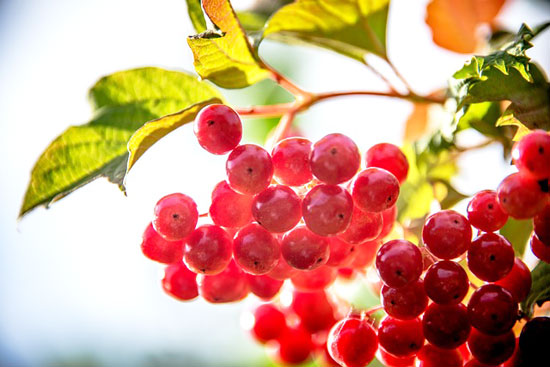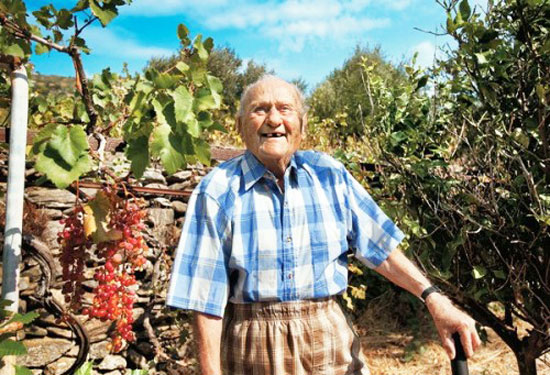Top Practices, Herbs and Foods to Encourage a Long and Vibrant Life (2)
Read the first part of the article
Time-Tested Herbal Superstars
Schizandra (Schizandra chinensis)

Asian cultures have a long history of using herbs and plants to promote vitality and increase lifespan. One of the most treasured is schizandra, a remarkable adaptogenic herb that counteracts everything from nervous exhaustion to aging and poor libido. A tiny, bright red berry, schizandra is part of the magnolia family and native to China, Japan, Korea as well as Russia.
According to Taoist masters, the berry is one of the few herbs to contain all three treasures (the energies of Essence, Vitality and Spirit), which is why they recommended the berry to their students. Anyone working with the inner energy of the body could greatly benefit from its use, especially to promote mental acuity and agelessness.
Schizandra also embodies the five flavors – sweet, sour, salt, bitter and pungent. For this reason, the berries are not palatable in the conventional sense and are specifically used as a medicinal tonic. An authentic adaptogen, schizandra is non-toxic and safely reduces stress while encouraging stable energy. It demonstrates superb antioxidant and anti-inflammatory characteristics as well, which, in turn, fosters radiant skin and offers protective benefit for the liver, particularly in the treatment of hepatitis.
Eleuthero (Eleutherococcus senticosus)
Yet another potent adaptogen, eleuthero is a top notch herbal remedy for creating bulletproof health. Considered a valuable medicine for over 2,000 years, eleuthero is native to northeast Asia, parts of Russia, China, Japan and Korea. Famously used to improve performance (both athletic and mental), the herb helps to increase oxygen uptake. It also prevents illness and fatigue, and boosts sexual function.
Eleuthero’s beneficial impact on the cardiovascular system is attributed to flavonoids; polysaccharide content have anti-tumor properties; sexual and adrenal support is due to sterols, while the sedative activity is owed to coumarins in the herb.
Fo-Ti (Polygonum multiflorum)
As a legendary longevity tonic reputed to boost libido, support functioning of the heart and brain, and return gray hair back to its original color, fo-ti is a medicinal tonic to be reckoned with. The adaptogen has been used for high cholesterol, fatigue, insomnia, diabetes, tuberculosis, cancer and vertigo. From a scientific perspective, fo-ti (sometimes known as ho-shou-wu), contains resveratrol and lecithin – two compounds that help lower cholesterol levels and improve circulatory function.
Reishi (Ganoderma lucidum)
Celebrated as the “mushroom of immortality” in the Taoist tradition, reishi is used to heal cardiovascular disease, arthritis, cancer and immune disfunction. The mushroom also boosts energy and acts as an tonic for overall well-being. Science has discovered that reishi stimulates brain neurons and also thwarts the development of new fat cells in obese individuals.
It has therapeutic value for asthma, allergies, autoimmune disorders, Alzheimer’s and Parkinson’s, diabetes and liver complaints. Studies have found the life-extending properties of the mushroom to be 9% to over 20% or, in human terms, 7 to 16 years.
Gynostemma (Gynostemma pentaphyllum)
A member of the cucumber and gourd family, gynostemma doesn’t produce the typical fruit, but instead, bundles of small black berries. Native to Vietnam, China and Japan, gynostemma is naturally sweet. An adaptogen, the berry helps to promote equilibrium and robust health. Trials suggest the herb is beneficial for the liver and blood. Moreover, it’s a powerful antioxidant and has gastroprotective properties.
Maidenhair tree (Ginkgo biloba)
Considered a “living fossil” which was around during the time of the dinosaurs, ginkgo biloba has been used in Chinese Traditional Medicine for centuries. Maidenhair trees are extremely long-lived, with the oldest documented tree being 3,500 years old.
Ginkgo is celebrated for its ability to increase circulation to the brain, which in turn is helpful for those suffering from Alzheimer’s, dementia and vertigo. The herb is also used to treat varicose veins, hemorrhoids, macular degeneration, glaucoma and erectile disfunction. Additionally, ginkgo is an outstanding antioxidant and helps to shield against free radical damage to DNA.
Shilajit (Asphaltum)
One of the most important medicinals in Ayurveda, shilajit is known as the “conqueror of mountains and destroyer of weakness.” Used for diabetes and regulating blood sugar, the compound also purifies the blood, reduces fat, dissolves tumors, improves digestion and strengthens the pancreas. Shilajit is considered a tonic for boosting virility as well.
Chaga (Inonotus obliquus)
A fungus that grows on birch and other hardwood trees, chaga is effective against a range of cancers – including those of the liver, uterus, breast, colon, skin, cervix and lung. A unique feature of the mushroom is that it only attacks tumor cells without troubling normal tissue.
Researchers in Seoul, South Korea established that cells treated with an extract of chaga had 40 percent less DNA mutations compared to untreated cells. Scientists believe chaga’s immune enhancing characteristics are due to the presence of beta glucans, which trigger T-cell activity and the production of antibodies.
The mushroom is also a rich source of sterols, flavonoids, polysaccharides, polyphenols, vitamins and minerals. What’s more, chaga is antiviral and anti-inflammatory. Natives of China, Siberia, Finland, Japan, Poland and North America have all appreciated chaga’s outstanding healing merits for hundreds of years.
Learn From Healthy Hotspots Around the World

No list concerning longevity would be complete without exploring the influence of diet. In 2000, Dan Buettner, a National Geographic explorer, set out to solve the mystery of centenarians around the world.
Subsequently, the book The Blue Zones: 9 Lessons for Living Longer from the People Who’ve Lived the Longest, was born. He found that these communities all had similar qualities in common. They move, a lot. They carve out time to relax. Community is important, many times with a religious focus. Their social circles support healthy behaviors. And they’re devoted to family life.
Now Buettner has tackled the question: what do Blue Zone communities eat? How much and when? To qualify, the group had to be mostly free of ailments like obesity, cancer, heart disease and diabetes.
This is what he discovered:
Inhabitants of Ikaria, Greece consume potatoes, goat’s milk, honey, wild greens, a bit of fruit, legumes (mainly garbanzo beans, lentils and black-eyed peas) and small amounts of fish. They also enjoy lemons and herbs like marjoram and sage in their tea. Sometimes Ikarians will eat goat meat, but not often.
For those in Okinawa, Japan, their diet includes bitter melon, tofu, garlic, green tea, brown rice, seaweed, turmeric, sweet potato and shiitake mushrooms.
Sardinians in Italy focus on goat’s milk and sheep’s cheese, sourdough bread, barley, fennel, fava beans, chickpeas, tomatoes, almonds, milk thistle tea and wine made from Grenache grapes.
And residents of the Nicoya Peninsula, Costa Rica, also known for their longevity, eat beans, corn, squash, papayas, yams, bananas and peach palms – a Central American fruit brimming with vitamins A and C.
Surprisingly, a community in the United States made Buettner’s list. Seventh-day Adventists in Loma Linda, California focus on a “biblical diet” with plenty of grains, fruits, nuts and vegetables – with water as their only drink. Sugar is shunned, unless it comes from natural foods like dates, figs or fruit.
Pesco-vegetarians in the community embrace a plant-based diet, but also includes one serving of fish per day. Staples encompass avocados, salmon, nuts, beans, oatmeal, whole wheat bread and soy milk.
All Blue Zones shared the following characteristics concerning diet:
• Eat the lightest meal of the day in the late afternoon or early evening.
• Only eat until about 80% full to side-step weight gain.
• Adhere to a mostly plant-based diet, one with an emphasis on beans.
Not included in Buettner’s research, but known for their life expectancy of 100+ years, people living in Bama Yao, China have traditionally included a novel element in their diet: hempseed. As with other hot spots of longevity, residents of Bama Yao thrive on a nutrient-rich diet and benefit from a pristine environment. But it appears a tiny seed of the hemp plant is the secret to their exceptional life span.
Hempseed is rich in a range of vitamins, minerals, antioxidants and healthy fats – like calcium, magnesium, potassium, sulfur and iron, with ample amounts of A,B, C, and E. Omega-3 and -6 fatty acids round out the stellar nutritional profile and encourage a keen mind and robust heart health.
One rare omega-6 oil found in hempseed – gamma linolenic acid (GLA) – combats inflammation, asthma, rheumatoid arthritis, atherosclerosis, diabetes and cancer. As an added bonus, the seed also contains noteworthy levels of phytol (a powerful antioxidant), which reduces the risk of cancer.
Back in the West, another food is making waves on the health front. Researchers have found that people who eat a 1-ounce serving (about a handful) of nuts a day live longer than those who don’t consume nuts on a regular basis. The team believes part of the reason nuts are so beneficial is because they curb appetite, ultimately leading to less food intake and weight gain. They also help manage blood sugar levels.
Whether you opt for a specific yogic practice, embrace herbal remedies, look to food as medicine or try a bit of everything, one aspect is certain: we need not be at the mercy of genetics or our environment. Instead, we can take an active roll in our health, and in the process, enjoy a bright and buoyant life now and in the future.
yogaesoteric
December 19, 2019
Also available in:
 Français
Français
